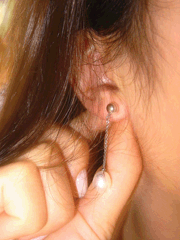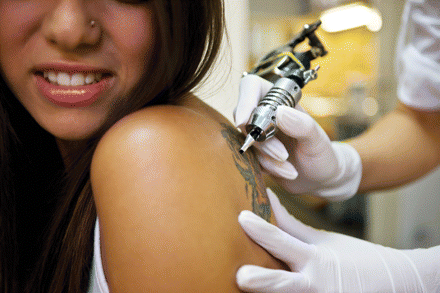In the far-off past, tattoos were something only sailors had, and the only body part people pierced was their ears. Nowadays, piercings and tattoos are everywhere. But like anything you do in life — from driving a car to playing a sport — tattoos and piercings come with some risks. Taking a few precautions will help you get the best results from your new body art and avoid side effects, which can include allergic reactions to inks or piercing jewelry, infections caused by unsterile equipment and needles, and scarring.
“Body art is a popular form of self-expression, but people who decide to get a tattoo or body piercing should go to a licensed facility and take time to discuss the safety procedures with the artists working at the shop or tattoo parlor,” says Scott Bryan, a spokesman for the U.S. Centers for Disease Control and Prevention.
Fortunately, tattoos and piercings are safer than ever, but before you become a proud owner, it’s important to do your homework. Body artists are expected to adhere to strict safety procedures. By following safety procedures, tattoo artists and body piercers protect themselves and their customers from a range of viruses and bacteria that can cause illness.
Time out for tattoo talk
You’ve been working on a cool design and saving up for your first tattoo. Now it’s time to find a reputable studio and artist who will transfer your artwork from paper to skin. Tattoos are designs on the skin made with needles and colored ink. Getting “inked” is a major decision. Keep in mind that a tattoo is effectively permanent, and although it is possible to remove a tattoo, the process is expensive and painful.
“Go to an established tattoo shop, and ask questions when you go there,” says Mike Martin, vice president and health and education coordinator for the Alliance of Professional Tattooists. “With all your power, avoid going to somebody’s house for a tattoo.”
Fortunately, more and more states and counties are regulating tattoo studios and artists. But all too often, says Martin, tattoos are done in kitchens and garages, because tattoo equipment is inexpensive and easy to obtain. Getting a tattoo from unsterile equipment and inexperienced artists can put you, and the artist, at risk for life-threatening infectious diseases such as hepatitis or skin infections caused by certain bacteria. Martin advises tattoo seekers to do their homework. Find a legitimate facility and ask for a tour — the shop should be neat and clean. Don’t be shy about talking to the artists about safety procedures.
“Ask whether they have had training in bloodborne pathogen and safe tattooing techniques,” Martin advises. “And ask if they use disposable products such as disposable tubes and needles and if they have a working sterilizer on the premises to clean their equipment.”
Once you’ve received your “ink,” follow all of the aftercare instructions provided by the artist. Always make sure you wash your hands before and after you touch your new tattoo until it is completely healed.
Mother graphic by Michele Late. Other art and graphics courtesy iStockphoto: Ear, Andrea Velez-Greene; earrings, Rohit Seth.
Piercing patter
From ears to noses to navels, piercings are a popular option for self-expression. But because piercings break the skin’s protective barrier, there are some health risks, including allergic reactions to the jewelry and diseases spread through blood. Reputable piercers adhere to strict safety procedures to protect their customers and themselves, but as with tattoos, there are no standardized U.S. piercing regulations.
“You can’t be confident that there is someone else looking out for your safety — you have to do that yourself,” says James Weber, president of the Association of Professional Piercers.
Take time to discuss safety procedures with the piercer. Ask about their process and clarify that the facility is clean and that the person doing the piercing uses proper hand-washing techniques as well as fresh, disposable gloves and sterilized instruments — and that the needle being used is new. Be aware that certain piercings take longer to heal than others, and have a longer window in which they can get infected, so follow your aftercare regimen to the letter until the piercing is completely healed.
“Very often people reach for cleaning solutions that are not appropriate for piercings, such as hydrogen peroxide and rubbing alcohol,” Weber says, noting that those chemicals are harsh and can damage tissue.
A final word of advice: Never get a piercing if you’ve been drinking, or when you’re on vacation and can’t take care of it afterward or aren’t sure if the equipment and water source is sanitary.
Be picky where you pierce
Beware of home piercing kits, which are readily available on the Internet and give minors a way around age restrictions at reputable shops. Such kits put users at risk for infections, including diseases spread through blood. Also, steer clear of piercing guns. Though widely used in malls, parts of the guns can’t be sterilized, warns Weber of the Association of Professional Piercers.
It’s also important to use the proper jewelry for a piercing, as the quality of jewelry varies.
“Very often, you do get what you pay for,” Weber says, noting that some people develop allergic reactions to inexpensive jewelry.
>> For more tattoo and piercing safety tips, visit www.safepiercing.org and www.safe-tattoos.com
- Copyright The Nation’s Health, American Public Health Association














